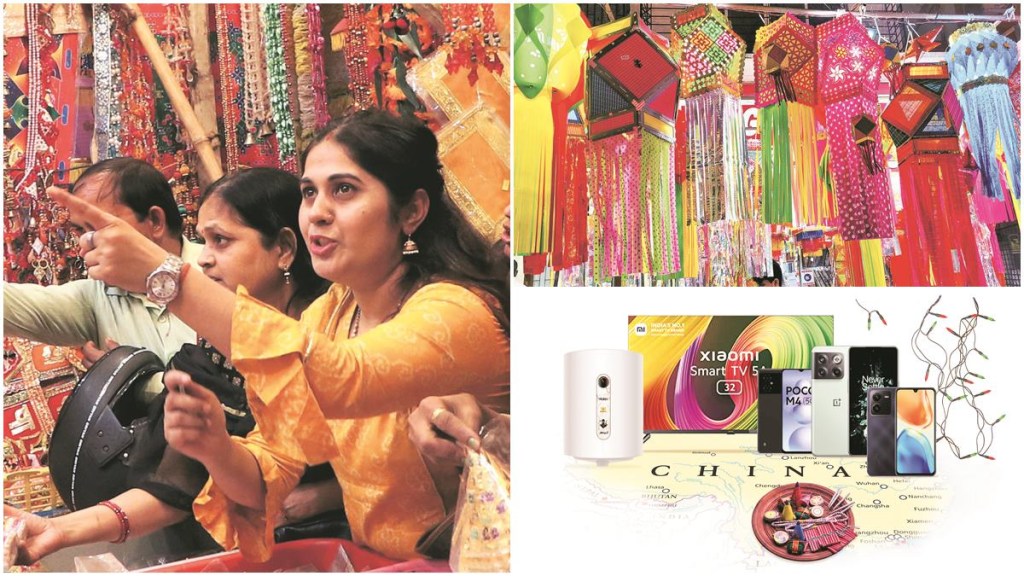Rahul Pardasany (name changed) is an ardent votary of all things Indian. The 29-year-old MNC executive from Delhi is quite vocal when it comes to promoting products manufactured in India, especially social media.
His views might echo the Centre’s increasing push to reduce reliance on China, but it’s easier said than done, because Indians’ dependence on Chinese products even in their daily lives, and especially during the festive season, is far from over.
Pardasany himself owns a Redmi Note 11 mobile phone, a popular brand of Chinese consumer electronics manufacturer Xiaomi. His family members also use phone models that include the Moto G60 and Oppo F19—all Chinese smartphone brands. Although he drives a Hyundai i20, his parents own an MG Hector Plus. The popular SUV is Chinese-owned British carmaker Morris Garages’ first stab at the Indian market.
A trip to Sadar Bazar—one of the largest wholesale markets in the national capital dealing in everything from household goods to toys, imitation jewellery, and festive supplies—is a revelation for Pardasany, who finds that China is India’s largest provider of Diwali merchandise, ranging from cheap firecrackers to ornamental LED lights, lanterns, gift items, home decoration items and fake flowers.
Although the past couple of years have been devoid of firecrackers owing to bans by several states, and the waning consumption of Chinese products amid the repeated boycott calls given by trade bodies and the general public alike since the Sino-Indian border skirmishes in Galwan in 2020, the fact remains that Chinese products are a mainstay of the traders’ economy in the market and underline the continuing thirst for Chinese goods in India.
Gadgets, mobiles & more
Even though India depends heavily on its northern neighbour in many key sectors, gadgets and electronic/ mobile accessories are some of the top categories where Indians buy ‘Made in China’ products, as per a survey undertaken by community social media platform LocalCircles earlier this year. “According to most consumers, the Indian counterparts for Chinese products are generally more expensive though they might be of better quality than the latter. However, many festival-related items like LED lighting, tea-light candles, and other plastic-made products are one-time-use products and hence quality is not the top criteria for many consumers. Products like mobile phones, air purifiers, gadgets, and appliances, as per consumers, are mainly made in China, and are equal or better in quality too,” the survey notes.
As per the survey, up to 29% of Indian households, in the past year, had purchased gadgets such as smartphones, tablets and smartwatches, and another 29% said they bought electronic/mobile accessories.
As per global technology market research firm Counterpoint Research, Chinese tech giant Xiaomi led the Indian smartphone market in the second quarter of 2022 with a 19% shipment share. While South Korean electronics major Samsung led the 5G smartphone segment with a 25% share, it was followed by Vivo and OnePlus, both Chinese tech companies. Also, three of the top five smartphone models in Q2 2022 were from realme, another Chinese consumer electronics manufacturer based in Shenzhen, Guangdong.
Meanwhile, in June, Morris Garages, better known as MG Motor, the British automotive marque now owned by Chinese state-owned automaker SAIC Motor, said its India subsidiary, MG Motor India, sold 4,008 units in May 2022, registering a strong growth of 99.6% compared to April 2022, and 294.5% growth compared to May 2021.
MG Motor India sold 2,008 units in April 2022 and 1,016 units in May 2021. It reached its 1 lakh sales milestone in May, having been in India for three years.
After two consecutive washed-out years, consumer durable brands are also seeing signs of recovery this year. Haier, a Chinese multinational home appliances and consumer electronics company, aims to achieve 40% growth in the company’s topline in 2022. “With our second industrial park in Greater Noida operational, Haier is now equipped to achieve its future growth plans till at least 2024,” Satish NS, president, Haier Appliances India, said in a report that appeared in FE earlier this year.
Market reality
Come festive season, and most Indians head to local markets to not only get the best deals, but also to soak in the festive spirit of colourful bazaars and decorated shops. Usually, this simply means buying affordable Chinese products. Every year, during the festive season, which begins from Rakhi and ends with Diwali, Indian traders and exporters import goods worth approximately Rs 50,000 crore from China. This year, however, things might be different.
“This year’s Diwali has brought cheer for traders in terms of good business prospects. After a slump in the last two years due to Covid, a large number of consumers are expected to throng markets. We are hoping to see a substantial increase in the purchases, and for Indian goods as well. Many consumers enquire if the products they are buying are not China-made,” says Praveen Khandelwal, secretary-general of the Confederation of All India Traders (CAIT), an apex body of the trading community of India.
Also Read: Diwali and diamonds: Festive and wedding season fueling the diamond jewellery market
Khandelwal is clearly referring to the developments in the past couple of years since the border skirmishes in the Galwan Valley along the Chinese border that led to a campaign to boycott Made in China goods.
CAIT estimates Chinese exporters to suffer business losses worth Rs 50,000 crore this Diwali season due to the boycott call. “The traders have procured sufficient stocks of Indian goods and are prepared to meet the expected demand,” adds Khandelwal. The traders’ body also expects that consumers may spend about `125 lakh crore during the Diwali festival sale period.
Prominent retail verticals like FMCG goods, consumer durables, toys, consumer electronics, electrical appliances and goods, kitchen articles and accessories, gift items, personal consumables, confectionery items, home furnishing, tapestry, utensils, builders hardware, footwear, watches, furniture and fixtures, garments, fashion apparel, cloth, home decoration goods, Diwali puja goods, including clay diyas, deities, wall hangings, handicraft items, textiles, good fortune symbols for home decor, decorative articles are the core sectors where Chinese goods have been replaced by Indian goods over the years.
Consumers can expect more Indian-made earthen diyas, lights, candles, colourful electric bulbs, home decor items, rangoli colours, ‘shubh labh’ symbols and other Diwali goods and materials for home decoration made by the craftsman, sculptors and various self-help women groups across country. “These are made all over the country, and craftsmen of Delhi, Rajasthan, Bihar, West Bengal, Jharkhand, Chhattisgarh, UP, Maharashtra and Assam particularly produce large quantities of goods,” adds Khandelwal.
Rising raw material costs and higher taxes are also reasons for the wane of Chinese products, says Paramjeet Singh Pamma, chairman of the Federation of Sadar Bazar Traders’ Association, Delhi. “We have reduced dependency on Chinese products from 100% to 50% or in some places to 25%,” he says, adding that India-made products are still expensive, and Chinese items such as gifts, decorative items, clothes, jewellery, crockery, lights and so on are much cheaper.
Pamma also points out that we still have a long way to go to start making or selling products cheaper than China. That’s because China has machine-made items, but we are still labour-intensive, and this is an additional expense. “In some industries, taxes are also high. Chinese products are comparatively 10-25% less in costs,” he adds.
Mohammad Nazim, a toy manufacturer in Sadar Bazaar, Delhi, feels demand for Chinese products may have lessened, but not diminished. “Overall market sentiment and selling is also down almost 50%. In the last three-four years for multiple reasons like imposition of duties and revised tax regime, the import from China is no longer as profitable as it used to be. But still there are certain products which are brought from China like crockery, daily household articles like mixer, brushes, duster, toys, electric equipment, door bell, mobile accessories, lights, bags, gas stoves, decorative lighting, bags, sun glasses, pens, stationery mobile accessories, gas stoves, chandeliers, and heavy machinery,” he adds.
Bridging the gap
The government’s ‘Make in India’ initiative is gaining momentum but there are reports that actually say that India has the potential to reduce imports from China by as much as 40% in the coming years. As per an analysis conducted by industry body PHD Chamber of Commerce and Industry, there are approximately 36 sub-sectors that can reduce India’s reliance on Chinese imports. “India holds the immense potential to reduce 40% imports (around $35 billion) from China in the coming times as there are various product categories that India also produces but at a lower volume,” Pradeep Multani, president, PHD Chamber of Commerce and Industry, said in the report, titled ‘Prospects and Potential for Enhancing Exports and Reducing Imports of India’, adding, “Since the domestic market has production capabilities, these sectors can readily minimise their reliance on China in a phased manner without any substantial extra investments.”








